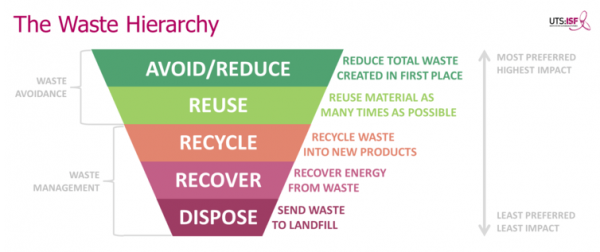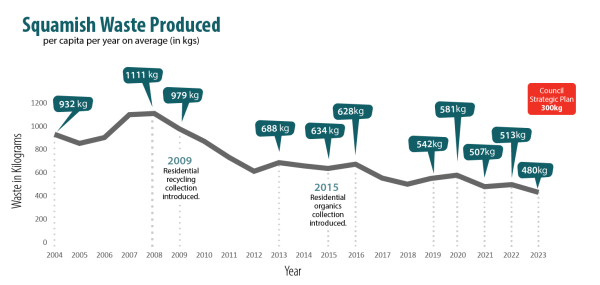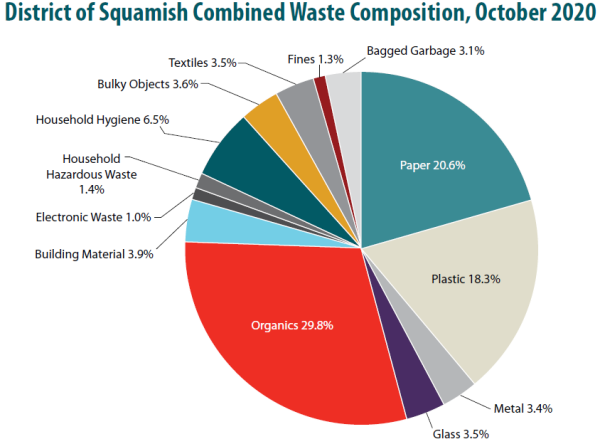Zero Waste
The District of Squamish aims to decrease the diversion of waste from landfill to 80%, and reduce per capita landfill waste to 300 kg.
View the Zero Waste Strategy.
Waste Diversion
Squamish has many waste diversion options, including:
- multiple drop-off locations for recycling and organics
- residential recycling and organics collection for all single-family and townhouses
- a free paint recycling location
- a drop off for reusable construction materials at Squamish ReBuild
- several extremely active non-governmental volunteer-based groups
How you can help
Practice the habit of bringing your own bag, cup, straw or other commonly used item to reduce waste in our community.
Composting food scraps, paper towels, dryer lint, coffee filters and other organic materials is the single most effective way to reduce your garbage waste. If you are unsure as to what materials can go in your organics tote, enter the item in our Waste Wizard lookup tool to find out where to recycle or dispose of it.
Cardboard, mixed paper, plastic containers, and metal such as tin and aluminum cans can all be recycled in the curbside recycling program. Styrofoam and plastic bags, overwrap/film and any glass that cannot be returned for a refund can be dropped off at the GFL Recycling Depot or the Squamish Landfill.
Buy bulk when possible and look for “pure” packaging products such as glass.
Keep bins for recycling, organics, glass, bottles and cans where you are likely to use it most, and consider setting up small containers in other rooms of your home, such as the washroom.
Previously loved goods are an excellent way to cut down on cost and packaging.
You can make a surprising number of things yourself (and save some serious cash at the same time). From bread to clothing to laundry soap, for recipes check out the Living Green website.
Read about recycling and going waste-free to learn about what others are doing. Watch The Story of Stuff, an eye opening animated, short film about the cycle of waste and consumerism. There is a lot of information out there that can help you reduce your garbage.
Writing a letter or calling a company goes a long way.

Waste by the Numbers
- 480 kg - the average of garbage disposed of per person in the District of Squamish in 2023.
- 350 kg - the target set by BC's Ministry of Environment of garbage disposed of per person per year by 2020.
- 505 kg - the provincial average of garbage disposed of per person in 2018.
- 525 kg - the average of garbage disposed of per person in the Squamish Lillooet Regional District in 2012.
In August 2020, the District of Squamish conducted a waste audit of what is being thrown in the garbage. The above chart represents the breakdown of the overall findings. View the full waste composition report here.
Some of the key findings from the Waste Composition Report -
- From Curbside Residential Collection, over 30% of the garbage is compostable. More than 10% of the garbage is avoidable Food Waste.
- Compostable Paper and Avoidable Food Waste are the 2 largest categories of material in Commercial Waste. They represent over 30% of the material in the garbage.
- 21% of the material in Multi-Family Garbage could be recycled at a Drop Off Depot, and 31% could be composted.
- Over 40% of the waste from the Construction and Demolition sector is Wood.
Resources
- The Story of Stuff
- Food Hacks (Love Food Hate Waste)
- Remove your name and address from advertising mailing lists
- Stop Trashing the Climate (report)
- Living Green (David Suzuki Foundation
- Waste Audit Tool (Excel file)
- Zero Waste Events Guide
Waste Reduction
You Can Live Without Producing Trash
http://www.youtube.com/watch?v=nYDQcBQUDpw


